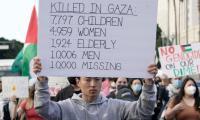The triumph of the Taliban may have created a ripple of excitement among right-wing circles in Pakistan but it has also sent a shiver down the spines of human rights activists, who fear reprisals and revenge killings.
The victory is haunting millions of Afghans that apprehend that the cloistered group of the militants will push the war-torn country towards the time of the 1990s when the Taliban smashed television sets and computers publicly, banned women education, handed down inhuman punishments, discriminated against religious and sectarian minorities, and opposed everything that had even an iota of modernity.
Although today's Taliban have tried to create an impression that they are changed now, and willing to respect international norms, the impression has not allayed the fears of the hapless people who fled in their tens of thousands, thronging the streets of Kabul. Tens of thousands of students, especially women, are nearing their graduation but the takeover could force them to give up their education. It is also alleged that militants outside of Kabul are demanding girls for marriage.
Although the Taliban appear to be more inclusive today than they were in the past, permitting ethnic and sectarian minorities to join their ranks, there are apprehensions among the non-Pashtuns that they would be targeted for allying with the government. The Taliban have clarified that no revenge will be taken, also announcing an amnesty for government employees and all those who have worked with the foreign occupying forces. This is a positive development – but despite these assurances thousands of people especially those affiliated with the police and the Afghan armed forces have left the country seeking refuge in neighbouring states. If the Taliban really mean to deliver on their promises then they should make efforts to bring back all such Afghans.
The fall of Kabul has also raised questions about the reasons that led to this situation. Many believe that, despite all tall claims of national unity, both former presidents – Hamid Karzai and Ashraf Ghani – turned out to be ethno nationalists, weakening Tajiks, Uzbek, Hazaras and other non-Pashtuns who offered stiff resistance to the Taliban in the past. It is alleged that the two former heads of the state came up with a policy that undermined the authority of leaders like Abdul Rashid Dostum, Atta Muhammad Noor and politicians from the Hazara community.
Ghani especially concentrated all powers into his hands ruling over the country like a king. It is alleged that his administration tried to drive a wedge between various tribes of non-Pashtun ethnic minorities, undermining their national unity by encouraging sub-identities within these nations. It is claimed that while the Pashtun were considered one ethnic entity, tribes in other nations were granted tribal identities in documents in a move to weaken them. Various dialects spoken by Tajik people were declared a language in a clever way and then ethnic identities were created on the basis of such languages. The Hazara were also divided into Arab, Sadaat and other types of clans.
It is asserted that ethnic minorities were also discriminated against in the affairs of administration. Although some important ministries were given to Tajik, Uzbek, Hazara and other ethnic groups, some declared and undeclared committees were formed on the top of these ministries to undermine non-Pashtun ministers. Most of the committee members were Pashtun, directly responsible to the president house that would intervene in the affairs of these ministries. Ghani, claim his detractors, was more afraid of these non-Pashtun ethnic minorities than the Taliban.
It isalso said that, instead of joining hands with anti-Taliban forces, the Kabul administration tried to eliminate them – forcing Abdul Rashid Dostum to go into exile, isolating Atta Muhammad Noor and turning a blind eye to the demands of the Hazara and other ethnic minorities. Noor's claim that some conspiracies were being hatched to trap General Dostum in the northern areas lends credence to speculations that not everything was hunky dory in the power corridors of Kabul.
Ghani's move, a few years ago, to reconcile with former Prime Minister Gulbadin Hekmatyar, who is also known as the butcher of Kabul, was viewed by non-Pashtun nationalists as an attempt to consolidate Pashtun hold on power. It is asserted that Ghani did not take the ethnic minorities into confidence before hobnobbing with Hekmatyar, who is an ethnic Pashtun. There was also an impression that Ghani and Karzai were soft on the Taliban and some asserted that had a similar insurgency been waged by non-Pashtun minorities, the reaction of the Kabul administration would have been much different.
It cannot be said that everything that went wrong in the war-torn country should be blamed on Ghani or the Kabul administration only but in reality the Kabul ruling elite, comprising war lords of other ethnic groups and the Pashtun upper classes, and the US share responsibility for the imbroglio that Afghanistan finds itself in today. Washington claims to have spent over a trillion dollars but in reality over $900 billion of this much-vaunted colossal amount was taken away by Americans themselves on different pretexts. A paltry $36 billion was allocated on governance and development while $88 billion is said to have been invested on the Afghan forces. A significant amount of this $36 billion was cleverly pocketed by international NGOs that allegedly also included the expenses of their offices based in London, Paris and New York in the total expenditures. The executives of these organisations received hefty salaries for working in one of the most impoverished countries on the globe.
What is done cannot be undone. The Taliban are a reality now, holding sway in Kabul. Whether they have changed or not is questionable but Afghanistan has been transformed over the last 20 years. During the time of the Taliban, hardly 70,000 students were enrolled in the country; this has risen to seven to ten million now. Shutting the doors of education on such a large number of students would be devastating. Similarly banning women from work, handing down inhuman punishments, imposing a dress code and thrusting a single ideology on the mass of the population should not be acceptable to the international community that provides 80 percent of 11 billion dollars that Afghanistan spent in 2019.
Around 47.3 percent of Afghanistan's population lives in poverty. Sixty out of every 1000 babies in 2019 died before reaching the age of five; with 41 percent poverty, the country has one of the highest rates of stunting of children in the world, severe acute malnutrition is 9.5. Only 42 percent of Afghans have access to safe drinking water, and only 27 percent of the rural population have access to sanitation facilities, resulting in diarrheal disease that claims the lives of an estimated 85,000 Afghan children. These are the pressing issues of Afghanistan. The real test of the Taliban lies in tackling these issues on an emergency basis rather than indulging in moral policing.
The writer is a freelance journalist.
Email: egalitarianism444@ gmail.com
Earth Day protests carry a vital message that is relevant 365 days a year. — AFP File Earth Day is celebrated every...
People walk along a market in Lahore on May 17, 2023. — AFP/FileMany of us had hoped that the general election...
Packs of freshly printed $20 notes are processed for bundling and packaging at the US Treasury's Bureau of Engraving...
People stand in line up as election officials check their ballot papers during voting general election at a polling...
Women show their voter identity cards as they stand in a queue before casting their votes in Agartala. — PTIThe 18th...
Former prime minister Imran Khan. — Instagram/ imrankhan.ptiAn old saying has it that “when you dance with the...







